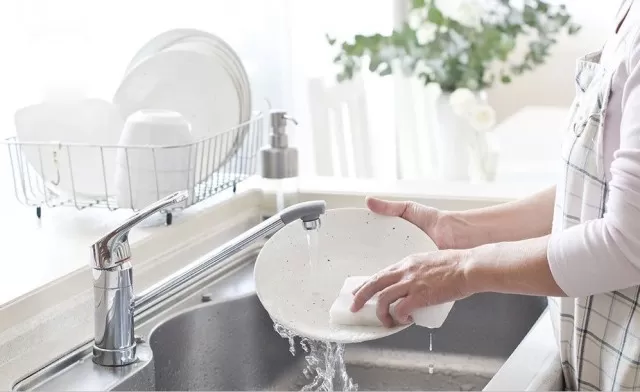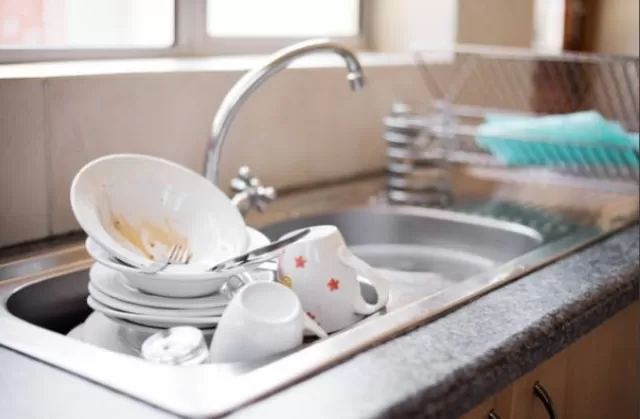While relying on the dishwasher for dishwashing has become more common, hand wash dishes can be a highly effective method.
Certain dishes, such as china, cast iron, and crystal, are not suitable for dishwasher use and require careful hand washing.
Additionally, tough residues like baked-on food often necessitate the use of extra effort. Whether you prefer soaking dishes or immediately washing and drying them, following a few simple tips can greatly simplify the process of hand washing, ensuring that your dishes are thoroughly cleaned and left spotless.
Wash Dishes By Hand

Hand wash dishes is a straightforward task, but there are some essential considerations to achieve spotlessly clean results.
Begin with the Right Tools.
Having the necessary supplies is crucial for successful hand washing.
Make sure you have a sponge and concentrated Dish Soap, and consider wearing rubber gloves to protect your hands and prevent dryness. Opt for a sponge with a soft side and a slightly textured side to cater to different cleaning needs.
It’s important to rinse and wring out the sponge thoroughly after each use, clean it regularly by running it through the dishwasher, and replace it when necessary to avoid bacterial buildup.
Using a drying rack can also be helpful during the dishwashing process.
It provides a separate space for wash dishes to air dry while you continue washing.
To Soak or Not to Soak?
Before washing, scrape or wipe off any large food particles into a trash can to prevent clogging the Sink Drain.
If you’re using a non-concentrated dish soap, soaking the dishes may be beneficial as it helps loosen grease and stubborn food residues. However, avoid soaking cast iron, as it can lead to rusting.
For other types of dishes, fill the sink with hot water and a small amount of dish soap to create suds, allowing you to submerge the dishes as you wash them.
Start with the Cleanest Items.
It’s advisable to wash the cleanest items first to avoid soiling the dishwater immediately.
Begin with drinking glasses and silverware that don’t have visible food residue. Dampen Your Sponge with warm water, add a few drops of concentrated dish liquid, and create suds by scrunching the sponge.
Use the sponge to scrub the dishes, starting with the cleanest ones and progressing to dirtier dishes like plates, bowls, and pots and pans.
Ensure you scrub the entire dish with the sponge, not just the visibly dirty spots, to eliminate bacteria.
Rinse each dish with running water and place it on the drying rack.
Using the Scrubbing Pad.
For most dishes without stubborn food residue, scrubbing with the soft side of the sponge should suffice.
However, when dealing with baked-on or tough-to-remove food, switch to the rough side of the sponge. The soft side is more effective for creating lather and holding water, while the rough side helps remove stubborn stains.
Avoid using the rough side on nonstick pots and pans or delicate dishes to prevent scratching or damaging their surfaces.
Drying the Dishes

Drying When Hand Wash Dishes.
While it’s not necessary to hand dry when you wash dishes, air drying is sufficient for items like pots, pans, plates, and bowls, which can be placed in a drying rack.
However, hand-drying certain dishes can prevent water spots. For glasses and stemware, allow them to air dry most of the way, then use a clean, dry towel or polishing rag to remove any remaining water droplets and polish them for a sparkling shine.
Handling Delicate China and Crystal
Specialty items and dishes with delicate designs require extra care.
Use a soft sponge without a rough texture and a gentle dish liquid specifically designed for delicate cleaning. Avoid using the scrubbing side of the sponge, as it can scratch the dishes and damage their decorations.
Apply light scrubbing pressure and gradually increase it if needed, ensuring not to scratch the surface or design fine china.
Crystal dishes need additional attention due to their softness.
Line the sink with a towel, hand washes the crystal items gently using a mild dish liquid and warm water, and wash one crystal item at a time. Place the washed crystal item on a dry towel spread over the countertop to allow it to dry and minimize the risk of breakage.
Items that Require Hand Wash Dishes

Always check the labeling or bottom of your dishes, pots, pans, and utensils to determine if they are dishwasher-safe or require hand washing.
Crystal and delicate china should always be hand washed to prevent damage. Knives are best washed by hand to avoid blade damage and loss of sharpness.
Wooden utensils should also be hand washed to prevent cracking.
Delicate silver utensils are better suited for hand washing to prevent tarnishing.
To extend the lifespan of nonstick pots and pans, hand washing is recommended. Lastly, cast iron should never be placed in the dishwasher, and certain plastic dishes may not be dishwasher-safe as they can melt if they come into contact with heating coils.
Most materials, such as stainless steel, metal utensils, glass, ceramic, and stoneware, can be safely washed in the dishwasher but can still be hand washed if desired.
*The information is for reference only.